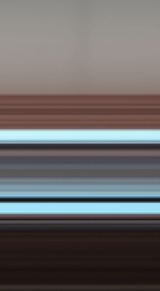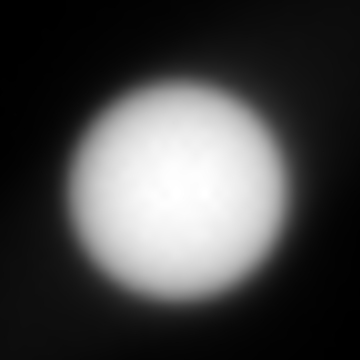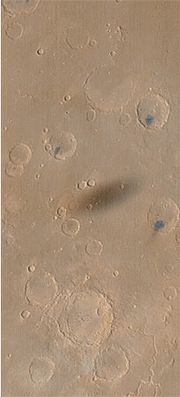
Transit of Phobos from Mars
Encyclopedia

Sun
The Sun is the star at the center of the Solar System. It is almost perfectly spherical and consists of hot plasma interwoven with magnetic fields...
as seen from Mars
Mars
Mars is the fourth planet from the Sun in the Solar System. The planet is named after the Roman god of war, Mars. It is often described as the "Red Planet", as the iron oxide prevalent on its surface gives it a reddish appearance...
takes place when Phobos
Phobos (moon)
Phobos is the larger and closer of the two natural satellites of Mars. Both moons were discovered in 1877. With a mean radius of , Phobos is 7.24 times as massive as Deimos...
passes directly between the Sun and a point on the surface of Mars, obscuring a large part of the Sun's disc for an observer on Mars. During a transit
Astronomical transit
The term transit or astronomical transit has three meanings in astronomy:* A transit is the astronomical event that occurs when one celestial body appears to move across the face of another celestial body, hiding a small part of it, as seen by an observer at some particular vantage point...
, Phobos can be seen from Mars as a large black disc rapidly moving across the face of the Sun. At the same time, the shadow (antumbra) of Phobos moves across the Martian surface.
The event could also be referred to as a particularly quick and shallow annular eclipse
Eclipse
An eclipse is an astronomical event that occurs when an astronomical object is temporarily obscured, either by passing into the shadow of another body or by having another body pass between it and the viewer...
of the Sun by Phobos.
Transit
A transit of Phobos from Mars usually lasts only thirty seconds or so, due to the moon's very rapid orbital periodOrbital period
The orbital period is the time taken for a given object to make one complete orbit about another object.When mentioned without further qualification in astronomy this refers to the sidereal period of an astronomical object, which is calculated with respect to the stars.There are several kinds of...
of about 7.6 hours.
Because Phobos orbits close to Mars and in line with its equator
Equator
An equator is the intersection of a sphere's surface with the plane perpendicular to the sphere's axis of rotation and containing the sphere's center of mass....
, transits of Phobos occur somewhere on Mars on most days of the Martian year. Its orbital inclination is 1.08°, so the latitude of its shadow projected onto the Martian surface shows a seasonal variation, moving from 70.4°S to 70.4°N and back again over the course of a Martian year. Phobos is so close to Mars that it is not visible south of 70.4°S or north of 70.4°N; for some days in the year, its shadow misses the surface entirely and falls north or south of Mars.
At any given geographical location on the surface of Mars, there are two intervals in a Martian year when the shadows of Phobos or Deimos is passing through its latitude. During each such interval, about half a dozen transits of Phobos can be seen by observers at that geographical location (compared to zero or one transits of Deimos
Transit of Deimos from Mars
A transit of Deimos across the Sun as seen from Mars takes place when Deimos passes directly between the Sun and a point on the surface of Mars, obscuring a small part of the Sun's disc for an observer on Mars...
). Transits of Phobos in the northern hemisphere happen during Martian autumn and winter; close to the equator they happen around the autumnal equinox and the vernal equinox; farther from the equator they happen closer to the winter solstice
Solstice
A solstice is an astronomical event that happens twice each year when the Sun's apparent position in the sky, as viewed from Earth, reaches its northernmost or southernmost extremes...
.
Observers at high latitudes less than 70.4° will see a noticeably smaller angular diameter for Phobos because they are considerably farther away from it than observers at Mars's equator. As a result, transits of Phobos for such observers will cover less of the Sun's disk. Because it orbits so close to Mars, Phobos cannot be seen north of 70.4°N or south of 70.4°S; such latitudes will obviously not see transits either.
Mars Rover Opportunity photographed transits of Phobos on March 7, 2004 and March 10, 2004 and March 12, 2004. In the captions below, the first row shows Earth time UTC and the second row shows Martian local solar time
Timekeeping on Mars
Various schemes have been used or proposed to keep track of time and date on the planet Mars independently of Earth time and calendars.Mars has an axial tilt and a rotation period similar to those of Earth. Thus it experiences seasons of spring, summer, autumn and winter much like Earth, and its...
.
 |
 |
| 02:46:23 08:16:41 |
02:46:33 08:16:51 |
 |
 |
 |
| 07:36:28 11:04:23 |
07:36:38 11:04:32 |
07:36:48 11:04:42 |
 |
 |
 |
 |
| 13:40:47 15:42:35 |
13:40:57 15:42:44 |
13:41:07 15:42:54 |
13:41:17 15:43:04 |
The data in the tables below is generated using JPL Horizons. There is some small discrepancy with the times reported for the series of images above. This may be due to imprecision in the ephemeris data used by JPL Horizons; also the JPL Horizons data gives local apparent solar time while the times reported above are probably some form of mean solar time (and therefore some of the discrepancy would be due to the Martian equivalent of the equation of time
Equation of time
The equation of time is the difference between apparent solar time and mean solar time. At any given instant, this difference will be the same for every observer...
).
| Duration Earth time (UTC) |
Duration (Local Solar time) |
Minim. separ. |
Phobos ang. diam. |
Sun ang. diam. |
Sun alt. |
|---|---|---|---|---|---|
| prior set of transits occurred in late April 2003 – early May 2003 | |||||
| March 7, 2004 (02:46:25 – 02:46:54) |
08 18 32 – 08 19 00 | 671" | 779.2" | 1230.7" | 34.6° |
| March 8, 2004 (01:39:58 – 01:40:31) |
06 35 36 – 06 36 08 | 517" | 665.0" | 1229.8" | 8.9° |
| March 10, 2004 (07:36:33 – 07:37:07) |
11 06 16 – 11 06 49 | 114" | 908.4" | 1227.6" | 76.3° |
| March 11, 2004 (14:47:15 – 14:47:53) |
17 27 19 – 17 27 56 | 193" | 669.4" | 1226.3" | 8.0° |
| March 12, 2004 (13:41:02 – 13:41:38) |
15 44 38 – 15 45 13 | 64" | 784.5" | 1225.5" | 33.7° |
| March 13, 2004 (12:30:00 – 12:30:28) |
13 57 16 – 13 57 42 | 625" | 880.4" | 1224.6" | 60.4° |
| next set of transits occurred in the second half of March 2005 | |||||
Viking 1
In the 1970s, the Viking 1Viking 1
Viking 1 was the first of two spacecraft sent to Mars as part of NASA's Viking program. It was the first spacecraft to successfully land on Mars and perform its mission, and until May 19, 2010 held the record for the second longest Mars surface mission of 6 years and 116 days .- Mission :Following...
Lander and Orbiter photographed the shadow as well. The Lander detected the penumbral shadow of Phobos passing across it.
This was detected only as a slight dimming of the ambient light; the Viking Lander camera did not image the Sun. The shadow took about 20 seconds to pass over the Lander, moving at about 2 km/s. The shadow was simultaneously imaged from the Viking 1 Orbiter, which permitted locating the position of the lander in the orbiter pictures.
August 26, 1999 image

Mars Global Surveyor
The Mars Global Surveyor was a US spacecraft developed by NASA's Jet Propulsion Laboratory and launched November 1996. It began the United States's return to Mars after a 10-year absence. It completed its primary mission in January 2001 and was in its third extended mission phase when, on 2...
and its high-resolution Mars Orbital Camera. One such image was taken on August 26, 1999 and shows the shadow at high resolution. This image was featured in a November 1, 1999 NASA press release.
By examining maps of Mars
we see the shadow is centered at around 10.9°N 49.2°W.
We can also look up the original image files at M04-03241 (red) and M04-03242 (blue), part of the gallery of MOC Wide-Angle Images, Region Lunae Palus, Subphase M04. The "image start time" was 03:26:13.01 UTC, the "line integration time" is 80.4800 milliseconds, and the "downtrack summing" factor is 4. Since the shadow is centered at 6400 pixels from the bottom of the original 10800-pixel-high image (Mars Global Surveyor had a south-to-north sun-synchronous orbit), we add (6400 × 0.08048 × 4) = 2060.3 seconds = 34 minutes 20.3 seconds to get a time of 04:00:33.3 UTC for the center of the shadow.
Putting in the longitude/latitude/altitude coordinate values -310.8,10.9,0 into
JPL Horizons we see that the predicted time of mid-transit was 04:00:36 UTC, in perfect agreement within the error of determining the exact longitude and latitude of the center of the shadow. This was about 14:41 Martian local solar time, and the Sun
Sun
The Sun is the star at the center of the Solar System. It is almost perfectly spherical and consists of hot plasma interwoven with magnetic fields...
's altitude was 46.5° above the horizon. JPL Horizons also shows that on August 26, 1999 the distance between the Earth and Mars was 9.6 light-minutes.
Other images

Note the timestamps printed on the photos in the NASA press release do not correspond to the actual time that the shadow was imaged, rather they represent the "image start time" of a vertically much larger original image. Mars Global Surveyor orbits Mars in a sun-synchronous polar orbit with orbital period
Orbital period
The orbital period is the time taken for a given object to make one complete orbit about another object.When mentioned without further qualification in astronomy this refers to the sidereal period of an astronomical object, which is calculated with respect to the stars.There are several kinds of...
117.65 minutes, moving from south pole to north pole, and continuously points its camera straight down. The result is an image in the form of a very long thin vertical strip, where the pixels in the top part of the image are imaged nearly one hour after those in the bottom part of the image. In principle the image could be as much as 43200 pixels high, but "downtrack summing" is used to merge adjacent lines. For instance, a downtrack summing factor of 27 causes every 27 lines to be merged into one, resulting in an image 1600 pixels high. Thus to determine the actual time that the Phobos shadow was imaged, it is necessary to locate the original image and measure how many pixels from the bottom of the image the shadow is found and add the corresponding offset to the image start time.
For example, we examine the image labeled with the timestamp 9/1/1999 20:13:05 (UTC). We have the original images M07-00166 (red) and M07-00167 (blue), part of the gallery of MOC Global-Map Images, Subphase M07. The shadow is situated at roughly 14°N 236°W.
In this case the image start time is 20:13:04.69 UTC, the line integration time is 80.48 milliseconds, and the downtrack summing factor is 27. The shadow is about 8 pixels high, centered at 993 pixels from the bottom of the original 1600-pixel-high image. We add (993 × 0.08048 × 27) = 2157.75 seconds = 35 minutes 57.75 seconds to get a time of 20:49:02.4 UTC for the center of the shadow.
Putting in the longitude/latitude/altitude coordinate values -124,14,0 into JPL Horizons gives an expected time of 20:49 for the transit, which is in good agreement once again. On September 1, 1999 the distance between the Earth and Mars was 9.9 light-minutes.
See also
- Solar eclipses on MarsSolar eclipses on MarsThe two moons of Mars—Phobos and Deimos— are much smaller than the Earth's moon, greatly reducing solar eclipses on that planet.-Eclipses caused by Phobos:...
- Astronomy on MarsAstronomy on MarsThe Astronomy on Mars article presents information and images about viewing astronomical phenomena from the planet Mars. In many cases these are the same or similar to those seen from Earth but sometimes they can be quite different...
- Transit of Mercury from MarsTransit of Mercury from MarsA transit of Mercury across the Sun as seen from Mars takes place when the planet Mercury passes directly between the Sun and Mars, obscuring a small part of the Sun's disc for an observer on Mars...
- Transit of Venus from MarsTransit of Venus from MarsA transit of Venus across the Sun as seen from Mars takes place when the planet Venus passes directly between the Sun and Mars, obscuring a small part of the Sun's disc for an observer on Mars...
- Transit of Earth from MarsTransit of Earth from MarsA transit of Earth across the Sun as seen from Mars takes place when the planet Earth passes directly between the Sun and Mars, obscuring a small part of the Sun's disc for an observer on Mars. During a transit, Earth can be seen from Mars as a small black disc moving across the face of the Sun...
- Transit of Deimos from MarsTransit of Deimos from MarsA transit of Deimos across the Sun as seen from Mars takes place when Deimos passes directly between the Sun and a point on the surface of Mars, obscuring a small part of the Sun's disc for an observer on Mars...
Further reading
- J. Bell, M. Lemmon, M. Wolff, Transits of Mars I and II, IAU Circ., 8298, 2 (2004).
http://cfa-www.harvard.edu/iauc/08200/08298.html(TeXTeXTeX is a typesetting system designed and mostly written by Donald Knuth and released in 1978. Within the typesetting system, its name is formatted as ....
DVI file is at http://cfa-www.harvard.edu/iauc/08200/08298.dvi).
External links
- JPL Horizons (must use telnet interface for non-Earth observation points)
- Opportunity image gallery: Sol 42 (small images of the March 7, 2004 grazing transit are near the top of the page).
- Opportunity image gallery: Sol 45 (small images of the March 10, 2004 transit are near the middle of the page).
- Opportunity image gallery: Sol 47 (small images of the March 12, 2004 transit are near the bottom of the page).
- Animation of March 10 2004 transit

